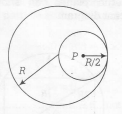Answer:
Option B
Explanation:
Central Idea Consider cavity as negative mass and apply superposition of gravitatiional potential.
Consider , the cavity formed in a solid sphere as shown in figure
V(∞)=0

According to the question, we can write potential at an internal point P due to the complete solid sphere.
$V_{s}=-\frac{GM}{2R^{3}}\left[3R^{2}-\left(\frac{R}{2}\right)^{2}\right]$
$=-\frac{GM}{2R^{3}}\left[3R^{2}-\frac{R^{2}}{4}^{}\right]$
$=-\frac{GM}{2R^{3}}\left[\frac{11R^{2}}{4}^{}\right]=\frac{-11GM}{8R}$
Mass of removed part
$=\frac{M}{\frac{4}{3}\times\pi R^{3}}\times\frac{4}{3}\times\pi\left(\frac{R}{2}\right)^{3}=\frac{M}{8}$
Potential at point P due to removed part
$V_{c}=\frac{-3}{2}\times\frac{GM/8}{\frac{R}{2}}=\frac{-3GM}{8R}$
Thus, potential due to remaining part at point P.
$V_{p}=V_{s}-V_{c}=\frac{-11GM}{8R}-\left(-\frac{3GM}{8R}\right)$
$=\frac{(-11+3)GM}{8R}=\frac{-GM}{R}$